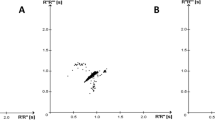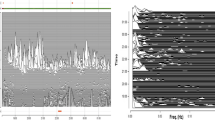Abstract
Purpose
Accurate identification of atrial fibrillation episodes from polysomnograms is important for research purposes but requires manual review of a large number of long electrocardiographic tracings. As automated assessment of these tracings for atrial fibrillation may improve efficiency, this study aimed to evaluate this approach in polysomnogram-derived electrocardiographic data.
Methods
A previously described algorithm to detect atrial fibrillation from single-lead electrocardiograms was applied to polysomnograms from a large epidemiologic study of obstructive sleep apnea in older men (Osteoporotic Fractures in Men [MrOS] Sleep Study). Atrial fibrillation status during each participant’s PSG was determined by independent manual review. Models to predict atrial fibrillation status from a combination of algorithm output and clinical/polysomnographic characteristics were developed, and their accuracy was evaluated using standard statistical techniques.
Results
Derivation and validation cohorts each consisted of 1395 individuals; 5 % of each group had atrial fibrillation. Model parameters were optimized for the derivation cohort using the Akaike information criterion. Application to the validation cohort of these optimized models revealed high sensitivity (85–90 %) and specificity (90–95 %) as well as good predictive ability, as assessed by the C statistic (>0.9) and generalized R 2 values (∼0.6). Addition of cardiovascular or polysomnogram data to the models did not improve their performance.
Conclusions
In a research setting, automated detection of atrial fibrillation from polysomnogram-derived electrocardiographic signals appears feasible and agrees well with manual identification. Future studies can evaluate the utility of this technique as applied to clinical polysomnograms and ambulatory electrocardiographic monitoring.



Similar content being viewed by others
References
Mehra R, Benjamin EJ, Shahar E et al (2006) Association of nocturnal arrhythmias with sleep-disordered breathing: the sleep heart health study. Am J Respir Crit Care 173:910–6
Mehra R, Stone KL, Varosy PD et al (2009) Nocturnal arrhythmias across a spectrum of obstructive and central sleep-disordered breathing in older men: outcomes of sleep disorders in older men (MrOS sleep) study. Arch Intern Med 169:1147–55
Monahan K, Storfer-Isser A, Mehra R et al (2009) Triggering of nocturnal arrhythmias by sleep-disordered breathing events. J Am Coll Cardiol 54:1797–804
Lian J, Wang L, Muessig D (2011) A simple method to detect atrial fibrillation using RR intervals. Am J Cardiol 107:1494–7
Blank JB, Cawthon PM, Carrion-Petersen ML et al (2005) Overview of recruitment for the osteoporotic fractures in men study (MrOS). Contemp Clin Trials 26:557–68
Orwoll E, Blank JB, Barrett-Connor E et al (2005) Design and baseline characteristics of the osteoporotic fractures in men (MrOS) study - a large observational study of the determinants of fracture in older men. Contemp Clin Trials 26:569–85
Somers VK, White DP, Amin R et al (2008) Sleep apnea and cardiovascular disease: an American heart association/American college of cardiology foundation scientific statement from the american heart association council for high blood pressure research professional education committee, council on clinical cardiology, stroke council, and council on cardiovascular nursing. J Am Coll Cardiol 52:686–717
Acknowledgments
The authors thank Lori Daniels, M.D., for her thoughtful review of the manuscript.
The Osteoporotic Fractures in Men (MrOS) Study is supported by National Institutes of Health funding. The following institutes provide support: the National Institute on Aging (NIA), the National Institute of Arthritis and Musculoskeletal and Skin Diseases (NIAMS), the National Center for Advancing Translational Sciences (NCATS), and NIH Roadmap for Medical Research under the following grant numbers: U01 AG027810, U01 AG042124, U01 AG042139, U01 AG042140, U01 AG042143, U01 AG042145, U01 AG042168, U01 AR066160, and UL1 TR000128. The National Heart, Lung, and Blood Institute (NHLBI) provides funding for the MrOS Sleep ancillary study “Outcomes of Sleep Disorders in Older Men” under the following grant numbers: R01 HL071194, R01 HL070848, R01 HL070847, R01 HL070842, R01 HL070841, R01 HL070837, R01 HL070838, and R01 HL070839.
Author information
Authors and Affiliations
Corresponding author
Additional information
Comment
We need investigations like this one. As clinicians, we often face distinct problems, such as how to discriminate atrial fibrillation from sinus rhythm in polysomnographic data. The authors have convincingly offered a feasible solution to this problem and thereby very likely helped to save dozens of hours of work for future investigations. Congratulations to the authors.
David Niederseer
Zurich, Switzerland
Rights and permissions
About this article
Cite this article
Monahan, K., Song, Y., Loparo, K. et al. Automated detection of atrial fibrillation from the electrocardiogram channel of polysomnograms. Sleep Breath 20, 515–522 (2016). https://doi.org/10.1007/s11325-015-1219-6
Received:
Revised:
Accepted:
Published:
Issue Date:
DOI: https://doi.org/10.1007/s11325-015-1219-6




